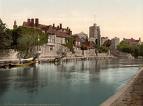Edward Barton Shuldham 1830 - 1915
October 05, 2009
 Edward Barton Shuldham 1830? -
1915? MD Trinity College
Dublin,
MRCS, MA
Oxon
was a British orthodox physician who converted to homeopathy,
Physician
at the St. James Homeopathic
Hospital, Member of the
British Homeopathic
Society,
Editor
of The Homeopathic
World,
and a frequent public lecturer on homeopathy and various
topics,
Edward Barton Shuldham 1830? -
1915? MD Trinity College
Dublin,
MRCS, MA
Oxon
was a British orthodox physician who converted to homeopathy,
Physician
at the St. James Homeopathic
Hospital, Member of the
British Homeopathic
Society,
Editor
of The Homeopathic
World,
and a frequent public lecturer on homeopathy and various
topics,
Shuldham was a friend of Lewis Carroll, and a colleague of James Compton Burnett, Edward Harris Ruddock,
Shuldham practiced in Croydon, Guildford, and at the Maidstone Homeopathic Dispensary,
Edward Barton Shuldham attended (Anon, The Homeopathic World, Volume 43, (1908). Page 236) the 2nd International Homeopathic Congress held in London (Anon, The Medical Counselor, Volume 7, (The Michigan State Homeopathic Society, 1883). Page 347) in on 11th-18th July 1881 (Anon, The Homeopathic World, (August 1,1881)) at Aberdeen House, Argyll Street, Regent Street.
Shuldham wrote The family homoeopathist, Headaches: their causes and treatment, The health of the skin, Coughs and their cure, Stammering and its rational treatment, Clergyman’s sore throat, or follicular disease of the pharynx, he edited Edward Harris Ruddock’s Essentials of diet: or, hints on food, in health and disease, and he submitted cases and articles to various homeopathic publications,
Shuldham also produced Pictures From Birdland with illustrations by his nephews Charles Maurice Detmold and Edward Julius Detmold,
Of interest:
Charles Maurice Detmold and Edward Julius Detmold, twins, nephews of Edward Barton Shuldham, illustrated Lewis Carroll’s Alice in Wonderland, Rudyard Kipling’s Jungle Book,
Charles Maurice Detmold and Edward Julius Detmold were English graphic artists, twins, born on 21 November 1883. Due to the illness of their father, they grew up in the care of their uncle, Edward Barton Shuldham, who had acquired a notable collection of Japanese woodprints of plants and animals.
This encouraged the twins to commence drawing animals and plants at a very early age, and resulted in a debut at the age of 13 at the Royal Academy and the Royal Institute of Watercolour Painters, with nature studies in the Japanese style.
The Detmolds subsequently learned techniques of watercolour etching and of colour printing with copper plates.
In 1898 they published their first sequence of colour etchings of animals and flowering plants in the Japanese style. These were much admired and were quickly out of print.
They achieved real success in 1900 in a special exhibition at the Fine Art Society’s Gallery in London.
In later works the influence of Albrecht Dürer becomes apparent. The watercolour illustrations for Rudyard Kipling’s Jungle Book were published in 1903 by Macmillan as coloured lithographs, making the twins ‘notoriously popular’. These illustrations, despite a certain colourfulness and fantasy in inventing tropical jungle scenery, still possess an intimate charm and display the masterly craft and high technical standard of their previous works.
Charles Maurice Detmold, who was probably the more gifted of the twins, became incapacitated and died at the age of 25 in 1908 (suicide). Edward Julius Detmold went on to carry out further illustrations notably Aesop’s Fables, and Maeterlinck’s Hours of Gladness and the Life of the Bee.
He continued with animal compositions and nature impressions, but in pursuit of his career, worked almost exclusively in coloured lithographs.
1899 - London: J. M. Dent & Co, New York: E. P. Dutton & Co. Light grey pictorial boards illustrated in red and black with a drawing of a woodpecker. Illustrated with 24 outstanding chromolithographs of birds with a facing poem by Dr. Edward Barton Shuldham (uncle to the Detmold boys).